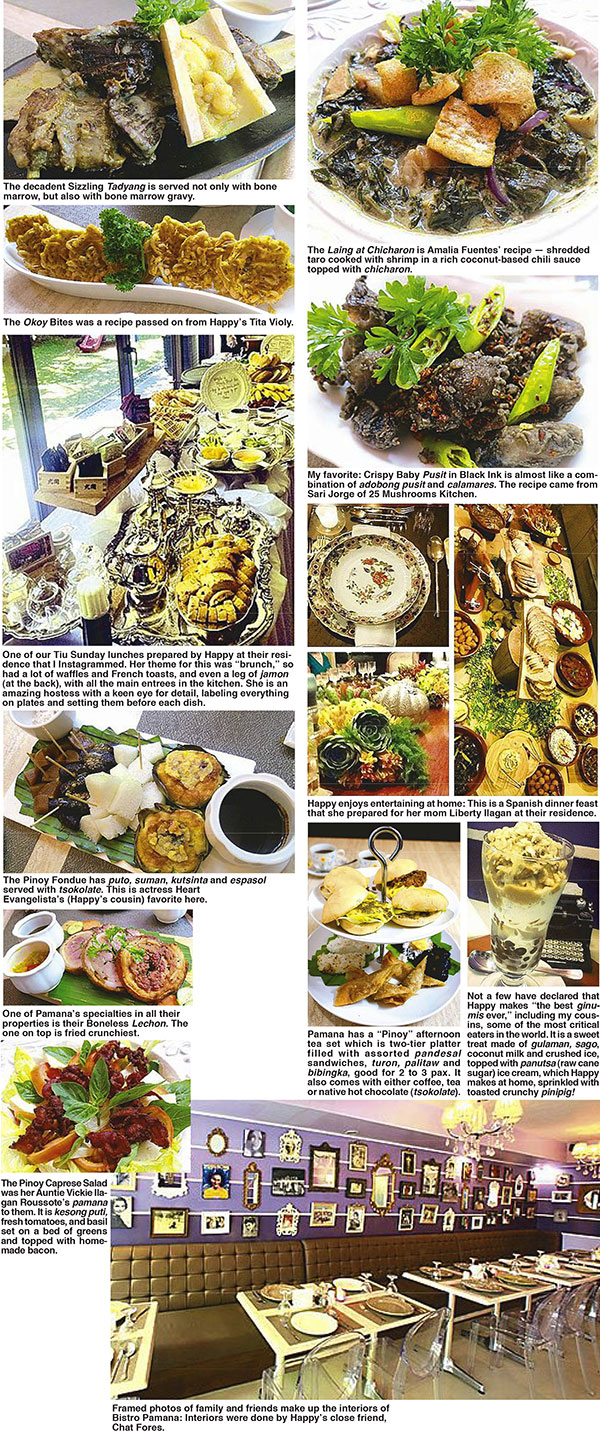Heirloom recipes that celebrate family

My family is like one big barkada. There are almost 50 of us — Ama, uncles and aunts and cousins — and we see each other every Sunday for our Tiu family lunch. The way it works is each family hosts a turn every week, starting from my dad’s eldest sibling down to the youngest. We’ve recently introduced a “cousins’ turn,” where the kids of the family (that’s us!) prepare a dish each per family (for example, my siblings and I have to come up with one dish for the entire clan, and so on) — and we have rules, too — no takeout from restaurants — so we don’t only learn to hone our culinary skills but exercise responsibility as well.
Whenever it’s our aunt Happy Ilagan Ongpauco-Tiu’s turn (we all call her “achi” because she and my dad’s younger brother Dexter are still bagets), the production level is always so coffee table book-feature-worthy. Everything is always so picturesque, themed, meticulously arranged, and most of all, delicious. Whenever I post a photo on social media, I get comments like, “Can you adopt us into your family so we can be part of your epic Tiu Sunday lunches?”
Well, guess what, now you all can. Bistro Pamana has recently opened on Perea Street in Legazpi Village, and you will feel like you are walking into the home of the Ilagans, Ongpaucos and Tius with photos of our families plus some of Happy’s close friends framed on the walls. Pamana takes its name from the passing down of heirloom recipes from generations of family members and friends, as those who have visited the Tagaytay and Boracay outposts know. The newest one in Makati is a bistro — which means it is a quaint 50-seater and offers a more curated menu.

HEARTY DISHES
The cuisine is Filipino — but with a heart. Every dish is labeled with the story behind it — whose recipe it was or whose favorite it is. I am particularly fond of the Crispy Baby Pusit in Black Ink (P230), as it is like our adobong pusit and calamares merged into one — simple, crunchy and addicting. The recipe is from Happy’s close friend, Sari Jorge of 25 Mushrooms Kitchen.
Those who grew up eating at World Topps in Katipunan (Happy’s first restaurant which she started at 23) will be pleased to know that the Adobo Flakes (P140) which made her restaurant famous is served here as well — this time as a centerpiece appetizer rather than a rice topping.
My uncle Dexter’s favorite is the Pork Sisig (P260), which she serves with a spoonful of aligue to be mixed on the sizzling plate. The Pinoy Caprese Salad (P185) substitutes the Italian mozzarella with our local kesong puti topped with homemade bacon, a recipe of her aunt Vickie Ilagan Roussote. Laing at Chicharon (P195) is Amalia Fuentes’ version of the Bicolano specialty of shredded taro cooked with shrimp and topped with chicharon.
The lechon (P680), cooked two ways — roasted then deep-fried — is a specialty here. It is served boneless stuffed with lemongrass, rosemary, thyme and lots of garlic. “The sides are darker and crunchier because it’s deep-fried to make the skin crispier, then it’s sliced up, leaving the meat inside succulent and tender,” explains Happy.
The Kakaibang Tadyang ng Baka (P310) is, well, kakaiba talaga. It is the most indulgent I’ve tried to date — served with bone marrow gravy that’s to be poured on the crispy beef ribs sizzling on the hot plate. Yummm.
THE BEST GINUMIS
I like how Happy gives twists to quintessential Pinoy food, serving them in ways not seen before — but without altering the essence of the dish. For example, the Afternoon Tea Set (P380) is a two-tiered platter that has assorted pandesal sandwiches of lechon belly with adobo gravy, and kesong puti and pesto as finger foods; and replaces scones and cakes with turon, palitaw and bibingka, which comes with your choice of tea, coffee or tsokolate ah.
She also has the Pinoy Fondue (P200), where local sweets like puto, suman, kutsinta and espasol are served with tsokolate as the dip. This is Happy’s cousin, actress Heart Evangelista’s favorite dish here, and it’s also served at Pamana in Tagaytay.
Not a few have declared that Pamana makes “the best” ginumis (P110), including my cousins, some of who are the most critical eaters in the world. (In fact, the menu now states that it is “A Tiu favorite.”) The sweet treat made of gulaman, sago, coconut milk and crushed ice is topped with panutsa (raw sugar cane) ice cream, which Happy makes at home, sprinkled with toasted crunchy pinipig. As my cousin Beverly describes it, “All the components work together. The ice cream is rich and creamy. When you mix it, the frozen bits of coconut cream, sago and jelly make a really good chunky spoonful. There’s a nice crunch from the pinipig bits.” She adds, “Ginumis is my Christmas gift to myself every year.”
A CELEBRATION OF FAMILY
The front page of the Bistro Pamana menu reads, “A Legacy of Filipino Cuisine.” On the last page, a collage of family and friends is labeled “My Source of Inspiration.” More than celebrating Filipino cuisine, Pamana celebrates family. Unlike most restaurants, there is no delineation of which part of the Philippines each dish comes from, but rather who it comes from. This is the one restaurant that brings all dishes together, regardless of region or province, into celebrating something quintessentially Filipino — including our beautiful, family-oriented culture.

* * *
Bistro Pamana is located at G/F Greenbelt Mansion, 106 Perea St., Legazpi Village, Makati City. It is open Mondays to Fridays from 10 a.m. to 10 p.m., and Saturdays from 10 a.m. to 9 p.m. For reservations, call 815-1823, visit http://www.happyconceptgroup.com or http://www.pamanarestaurant.com/.
* * *
You can reach me at inbetweendeadlines@gmail.com, on my blog www.cheryltiu.com, on Twitter at www.twitter.com/cherytliu or on Instagram at www.instagram.com/chertiu.



















